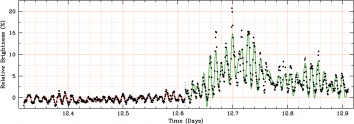Dying Stars Suffer from 'Irregular Heartbeats'
26 August 2015
AUSTIN — Some dying stars suffer from ‘irregular heartbeats,’ research led by astronomers at The University of Texas at Austin and the University of Warwick has discovered.
The team discovered rapid brightening events — outbursts — in two otherwise normal pulsating white dwarf stars. Ninety-seven percent of all stars, including the Sun, will end their lives as extremely dense white dwarfs after they exhaust their nuclear fuel. Such outbursts have never been seen in this type of star before.
“It’s the discovery of an entirely new phenomenon,” said graduate student Keaton Bell of The University of Texas at Austin. Bell reported the first pulsating white dwarf to show these outbursts, KIC 4552982, in a recent issue of The Astrophysical Journal.
This week, a team led by recent University of Texas PhD J.J. Hermes, now of the University of Warwick, is reporting the second white dwarf to show this trait: PG1149+057. Hermes’ team includes Bell and others from The University of Texas. Their research is published in the current Astrophysical Journal Letters.
Both white dwarf discoveries were made using data from the Kepler space mission. The Kepler spacecraft trails Earth in its orbit around the Sun, recording time lapse movies of a few patches of sky for months on end.
The Kepler data show that in addition to the regular rhythm of pulsations expected from a white dwarf, which cause the star to get a few percent brighter and fainter every few minutes, both stars also experienced arrhythmic, massive outbursts every few days, breaking their regular pulse and significantly heating up their surfaces for many hours.
"We have essentially found rogue waves in a pulsating star, akin to ‘irregular heartbeats,’” Hermes explained. “These were truly a surprise to see: We have been watching pulsating white dwarfs for more than 50 years now from the ground, and only by being able to stare uninterrupted for months from space have we been able to catch these events.”
Bell elaborated: “When we build a telescope that observes the sky in an entirely new way, we’re going to end up discovering things that we never expected.” Though Kepler’s notoriety derives from its prowess as a planet hunter, “it’s told us at least as much about stars as it has about planets,” Bell said.
White dwarfs have been known to pulsate for decades, and some are exceptional clocks, with pulsations that have kept nearly perfect time for more than 40 years. Pulsations are believed to be a naturally occurring stage when a white dwarf reaches the right temperature to generate a mix of partially ionized hydrogen atoms at its surface.
That mix of excited atoms can store up and then release energy, causing the star to resonate with pulsations characteristically every few minutes. Astronomers can use the regular periods of these pulsations just like seismologists use earthquakes on Earth, to see below the surface of the star into its exotic interior. This was why astronomers targeted these stars with Kepler, hoping to learn more about their dense cores. In the process, they caught these unexpected outbursts.
“These are highly energetic events, which can raise the star's overall brightness by more than 15% and its overall temperature by more than 750 degrees in a matter of an hour,” Hermes said. “For context, the Sun will only increase in overall brightness by about 1% over the next 100 million years.”
There is a narrow range of surface temperatures where pulsations can be excited in white dwarfs, and so far irregularities have only been seen in the coolest of those that pulsate. Thus, these irregular outbursts may not be just an oddity; they have the potential to change the way astronomers understand how pulsations, the regular heartbeats, ultimately cease in white dwarfs.
“The theory of stellar pulsations has long failed to explain why pulsations in white dwarfs stop at the temperature we observe them to,” Texas’ Keaton Bell said. "That both stars exhibiting this new outburst phenomenon are right at the temperature where pulsations shut down suggests that the outbursts could be the key to revealing the missing physics in our pulsation theory."
Astronomers are still trying to settle on an explanation for these outbursts. Given the similarity between the first two stars to show this behavior, they suspect it might have to do with how the pulsation waves interact with themselves, perhaps via a resonance.
"Ultimately, this may be a new type of nonlinear behavior that is triggered when the amplitude of a pulsation passes a certain threshold, perhaps similar to rogue waves on the open seas here on Earth, which are massive, spontaneous waves that can be many times larger than average surface waves," Hermes said. "Still, this is a fresh discovery from observations, and there may be more to these irregular stellar heartbeats than we can imagine yet."
— END —
Science contacts
Keaton Bell, The University of Texas at Austin: +1-206-370-1455 (mobile)
Dr. J.J. Hermes, The University of Warwick: +44 (0)24-765-7369







